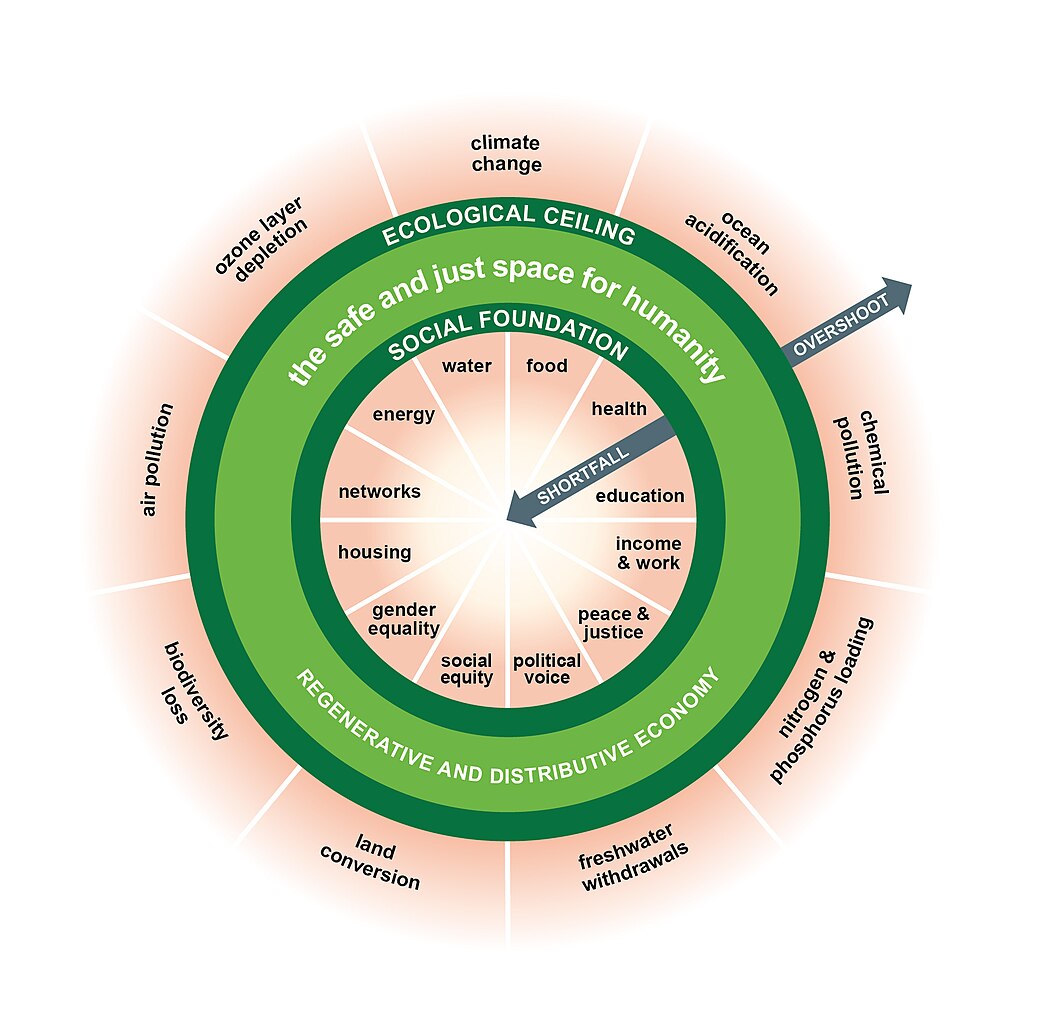In the face of growing ecological concerns and social inequities, the urgency to craft a better and more sustainable future has never been greater. Traditional economic models, predicated on infinite growth, are proving inadequate to address the interconnected crises we face. A radical rethinking of our approach is thus not only beneficial but essential. This is where British economist Kate Raworth steps in, offering a groundbreaking alternative – the Doughnut Economics model. I first thought it was a new recipe for an excellent old doughnut, but then I realized this is more about the future. It does relate to food, though, but not in the way we would think.
A senior research associate at Oxford University’s Environmental Change Institute and a professor of practice at Amsterdam University of Applied Sciences, Raworth has spent years studying the interface between economic theory, social justice, and environmental sustainability. Her profound insights culminated in the seminal book “Doughnut Economics: Seven Ways to Think Like a 21st-Century Economist” in 2017. This influential work proposes a shift from the traditional growth-at-all-costs model, positing a more holistic, sustainable paradigm for economic development.
Through Doughnut Economics, Raworth charts a course towards a future that ensures social fairness for all within the ecological limits of our planet – a sustainable future where humanity thrives in balance. As we delve deeper into this subject, we’ll examine the Doughnut model and explore how it could shape our collective future.

Why is this theory essential?
I recognize the profound significance and groundbreaking nature of Doughnut Economics, a model developed by Kate Raworth. At its core, this theory provides a compelling response to the two most pressing challenges of our times – social inequality and environmental degradation.
Traditional economic models focus on growth as a measure of prosperity, often at the expense of environmental sustainability and equitable wealth distribution. They operate under the assumption of unlimited resources, an idea fundamentally flawed given our planet’s finite nature. Such models fail to consider the ecological strain of unchecked growth and its repercussions for future generations.
Enter Doughnut Economics, a paradigm shift in economic thought. The model provides a framework for sustainable development within two boundaries: an inner social foundation, ensuring basic human necessities, and an outer ecological ceiling, limiting the strain on Earth’s resources. It highlights the interconnectedness of societal well-being and environmental health, presenting a vision for an economy that is regenerative and distributive by design.
This theory reframes the very notion of economic success. No longer is it about growing indefinitely but rather about thriving within the boundaries of our doughnut-shaped diagram. It encourages innovation, redesign of business models, and reimagining policies for transformative change.
The importance of Doughnut Economics cannot be understated in the context of climate change. It acknowledges the Earth’s planetary boundaries, ranging from greenhouse gas emissions to biodiversity loss. It aligns with the scientific consensus outlined in IPCC reports, providing a roadmap to limit global warming while striving for social justice.
Raworth’s Doughnut Economics, therefore, is more than a theory; it’s a call to action. It requires us to re-evaluate our priorities and redefine progress. It is a step towards aligning our economies with the reality of a finite planet and the ambition of a fairer world – honestly, a groundbreaking concept in economics and sustainability.
A short definition of what is the Doughnut economics
If I would need to define doughnut economics in a nutshell, this is what I would say. Doughnut Economics is a sustainable development model conceptualized by British economist Kate Raworth. It proposes a “safe and just space for humanity,” visualized as a doughnut or a circular band. The inner ring of the doughnut represents the minimum resources necessary for life—food, clean water, shelter, and social equity, among others. Falling short of the inner ring leads to deprivation. The outer ring of the doughnut depicts Earth’s environmental limits, and overshooting this boundary results in ecological degradation. The space in between, the dough of the doughnut, represents the optimal area where our needs can be met without straining the planet. Instead of pursuing infinite economic growth, Doughnut Economics argues for balancing people’s requirements with the planet’s finite resources.

The Doughnut economics in details
Let’s delve deeper into the concept of Doughnut Economics, created by Kate Raworth, to understand its mechanisms and implications for sustainable development.
The model is visually represented as a doughnut with two concentric rings. The inner ring, known as the ‘social foundation,’ outlines the minimum living standards every individual should enjoy. It encapsulates food and water security, access to quality healthcare, a decent education, housing, social equity, and a political voice. We want no one to fall short of these necessities. For instance, implementing policies like universal basic income (UBI) could help ensure everyone has an income that meets basic needs, preventing people from falling into the doughnut hole of social deprivation.
Beyond the social foundation lies the body of the doughnut, the ‘safe and just space’ for humanity. Sustainable development should occur in this balanced resource use and social equity zone.
However, this space has outer limits, represented by the ‘ecological ceiling.’ This boundary encapsulates the maximum pressure our planet can endure without compromising its stability. If we cross this limit, we risk exacerbating climate change, causing biodiversity loss, ozone layer depletion, and introducing a range of other environmental stressors. The global transition towards renewable energy is a tangible example of respecting this boundary. By replacing fossil fuels with wind, solar, and other renewable sources, we can limit harmful greenhouse gas emissions, helping to keep global warming within acceptable limits.
Living within the doughnut, therefore, involves meeting everyone’s essential needs (inner boundary) while ensuring we do not exceed our planet’s capacity to sustain life (outer perimeter).

But how can we achieve this balance? Raworth emphasizes a transformative shift towards a regenerative and distributive economy. Instead of the traditional linear economic model, where we take resources, make products, use them, and dispose of them, Doughnut Economics champions a circular economy. This approach minimizes waste and pollution through design, keeps products and materials in use, and regenerates natural systems. For instance, a company manufacturing smartphones could design them to be easily repairable, extend their longevity through software updates, and facilitate the recycling of components once the device reaches the end of its life.
Raworth also calls for a more equitable distribution of resources. This doesn’t mean just income and wealth but also the distribution of power and the opportunity for development. For example, embracing technologies that democratize access to information and services, such as widespread internet connectivity, can help distribute knowledge resources evenly across society.
In essence, Doughnut Economics isn’t just a theory but a comprehensive framework that calls for rethinking and redesigning our economic systems. It seeks to balance human development and environmental sustainability, reminding us to thrive, not just survive. This doughnut-inspired model is thus an ambitious roadmap for achieving social and ecological balance in our shared home, Earth.
To Conclude,
Doughnut Economics offers us an innovative, hopeful vision for the future. It provides a roadmap that charts the course from our current linear ‘take-make-use-dispose’ economic model to a more sustainable, regenerative, and equitable system. As we stand on the brink of environmental crises, such as climate change and biodiversity loss, Raworth’s model emphasizes the critical balance between ensuring everyone’s needs are met and not exceeding our planet’s ecological limits.
I see Doughnut Economics as a beacon of light guiding us towards a solution-driven future. It fosters economic innovation and social equity while safeguarding our ecological ceiling, thus underlining the interconnectedness of all life on Earth. It’s a compelling reminder that we are part of, not apart from, the web of life.
Our shared responsibility is to ensure that our planet’s future isn’t a hole-filled doughnut but a complete one, rich with fairness, regeneration, and sustainability. By embracing the principles of Doughnut Economics, we can ensure that every slice of our global economy contributes to a more wholesome future. After all, a balanced diet, like a balanced planet, requires a wholesome doughnut, not one with a gaping hole. Let’s make the doughnut, and therefore our world, whole again. The future of our planet is not just in our hands but in our actions too, and it’s time to make every bite count.
José Amorim
Information sourced by the author for luxuryactivist.com. All content is copyrighted with no reproduction rights available. Images are for illustration purposes only.
